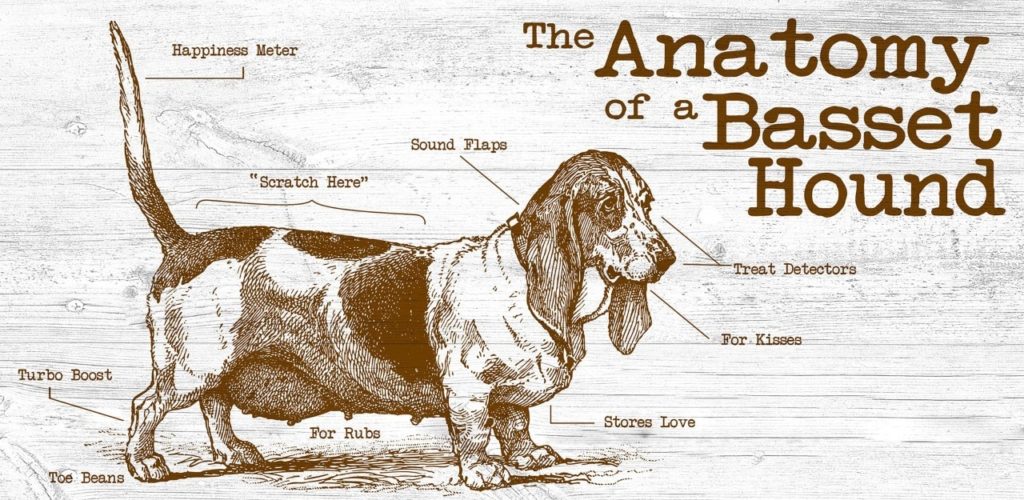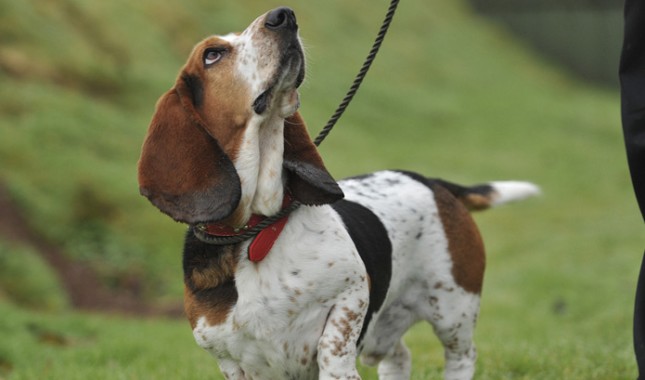The Basset Hound is a short-legged breed of dog in the hound family. The Basset is a scent hound that was originally bred for the purpose of hunting hare. Their sense of smell and ability to ground-scent is second only to the Bloodhound.
Basset Hounds are one of six recognised “basset”-type breeds in France. The name Basset is derived from the French word bas, meaning ‘low’, with the attenuating suffix -et—together meaning ‘rather low’. Basset Hounds are usually bicolours or tricolours of standard hound colouration.
History
The modern Basset Hound descends from French dogs that were bred in Great Britain in the late 1800s.
The earliest-known depictions of short-legged hunting dogs are engravings from the Middle Kingdom of Egypt. Mummified remains of short-legged dogs from that period have been uncovered in the Dog Catacombs of Saqqara, Egypt. Scent Hounds were used for hunting in both Ancient Greece and Ancient Rome.

St Hubert’s Hound
The basset type originated in France and is descended from the 6th-century hounds belonging to St Hubert of Belgium, which through breeding at the Benedictine Abbey of St. Hubert eventually became what is known as the St Hubert’s Hound around 1000 AD. St Hubert’s original hounds are descended from the Laconian (Spartan) Hound, one of four groups of dogs discerned from Greek representations and descriptions. These scent hounds were described as large, slow, ‘short-legged and deep-mouthed’ dogs with a small head, straight nose, upright ears and long neck, and either tan with white markings or black with tan markings. Laconian Hounds were reputed to not give up the scent until they found their prey. They eventually found their way to Constantinople, and from there to Europe.
France
The first mention of a “basset” dog appeared in La Venerie, an illustrated hunting text written by Jacques du Fouilloux in 1585. The dogs in Fouilloux’s text were used to hunt foxes and badgers. It is believed that the Basset type originated as a mutation in the litters of Norman Staghounds, a descendant of the St Hubert’s Hound. These precursors were most likely bred back to the St. Hubert’s Hound, among other derivative French hounds. Until after the French Revolution around the year 1789, hunting from horseback was the preserve of kings, large aristocratic families and of the country squires, and for this reason, short-legged dogs were highly valued for hunting on foot.
Basset-type hounds became popular during the reign of Emperor Napoleon III (r. 1852–1870). In 1853, Emmanuel Fremiet, “the leading sculptor of animals in his day” exhibited bronze sculptures of Emperor Napoleon III’s basset hounds at the Paris Salon. Ten years later in 1863 at the first exhibition of dogs held in Paris, basset hounds attained international attention.
The controlled breeding of the short-haired basset began in France in the year 1870. From the existing bassets, Count Le Couteulx of Canteleu fixed a utilitarian type with straight front legs known as the Chien d’Artois, whereas Mr. Louis Lane developed a more spectacular type, with crooked front legs, known as the Basset Normand. These were bred together to create the original Basset Artésien Normand.
England
French basset hounds were being imported into England at least as early as the 1870s. While some of these dogs were certainly Basset Artésien Normands, by the 1880s linebreeding had thrown back to a different heavier type. Everett Millais, who is considered to be the father of the modern Basset Hound, bred one such dog, Nicholas, to a Bloodhound bitch named Inoculation through artificial insemination in order to create a heavier basset in England in the 1890s. The litter was delivered by caesarean section, and the surviving pups were refined with French and English bassets. The first breed standard for what is now known as the Basset Hound was made in Great Britain at the end of 19th century. This standard was updated in 2010.
Hunting with bassets
The Basset Hound was bred to hunt, with a keen nose and short stature suited to small-game hunting on foot. A variety of Basset Hound developed purely for hunting by Colonel Morrison was admitted to the Masters of Basset Hounds Association in 1959 via an Appendix to the Stud Book. This breed differs in being straighter and longer in the leg and having shorter ears.
